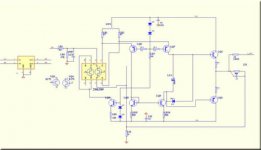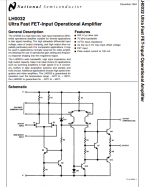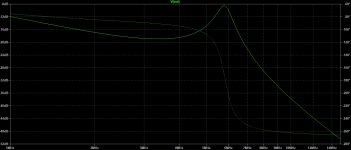'Amazing' might be taken to mean the best someone has heard so far, or maybe a system very close to that level. Once a better system is heard then the previous standard may not sound as amazing anymore. One never knows until one hears better.
Yes, Mark. I always smile when I heard people said "The amplifier is so accurate that it doesn't sound nice. It ruthlessly show what is in the recording. I need to add H2."
We need low defect amplifiers to NOT need patches. But the chance to get this experience is also smaller because you wont know what the amp can do unless the speakers is capable too.
I don't know. FYI I built my amp, it's old Hitachi lateral mosfets driven by LME49830 chips and my speakers are home made Jordan VTL and U-frame subwoofers.
Oh my. I believe it's the chip. I have an amplifier with LME opamp input stage. The detail is amazing too.
How you would evaluate if the system needs pre-distortion?
I try to imagine. First, feed in the amplifier a pure sinus then measure the acoustical spectrum and see presence of H2 generated somehow by the drivers. Ok. Then try to pre-distort with proper H2 generated in anti-phase, to cancel the acoustic response of driver?
But would this not be against most audio reviews tell, it is better to have a decent presence (to hear it) of H2? This is the Valve superiority mantra, and we try to cancel it.
Or, maybe you mean, that not a total cancellation is the goal?
And that would be optimized for a small volume range and track?
Would be then nice and useful to have a variable H2 dial... right?
Sorry if I did not understand or see how else to understand your answer. If you see here more than I do, could you detail a bit more please?
Imo, it is not the H2 that is important (but true that some people like it because it's sweet, in the absence of a better accurate sound) but how the H2 will mask other higher order distortions.
In class-B where there are lots of high-order distortion, reducing H2 doesn't make sense. But in class-A where low order and H2 usually dominates it does make sense. And H2 has a more consistent phase behaviour (than higher order ones) that intuitively I don't see why "pre-distortion" (I don't like the term either) not feasible.
Hi johnego,
Also, H2 is not always sweet, and can be pretty darned annoying.
No, why would you ask that? It is a common characteristic of all amplifiers.Isn't this related well with output topology used by many zero feedback class-B amplifiers?
Also, H2 is not always sweet, and can be pretty darned annoying.
Time for chuckles
I just built an HDAM (V1.3) "preamplifier" I bought off Ebay. I knew it would sound good and I figured, why the heck not?
Check this thing out, and yes, it does sound really good.
Yes, it is just simply sitting on top of the inner surface in an aluminum chassis box that I grounded. It is not screwed in, just sitting there.
What did I change from the kit as I built it? I threw out the resistors, 5% carbon film things and used mostly Dale RN55 resistors that I matched by hand. Then I matched the supplied transistors and stuck them together with heat shrink and some thermal grease. The supplied capacitors, 10 pF and 100 pF were replaced with Polystyrene types the ones supplied were ceramic axial ones.
The unit was on for maybe 10 minutes or less when I took the measurements. The only adjustment is for zero DC offset, which was done. It seems to be happy sitting around 1/2 a mV on each channel.
I'm feeding it +/- 20 VDC from an HP 6237B power supply 'cause I didn't have a transformer handy.
Here is the unit I bought on Ebay: NEW Marantz HDAM Circuit Preamp Kit Class A Output with 3-Bit Input Select | eBay It is item # 183526337118.
This kit sat here for months before I decided to build it today. I think there are still a couple left. The schematic is too blurry to make out any detail, but it is there.
-Chris
I just built an HDAM (V1.3) "preamplifier" I bought off Ebay. I knew it would sound good and I figured, why the heck not?
Check this thing out, and yes, it does sound really good.
Yes, it is just simply sitting on top of the inner surface in an aluminum chassis box that I grounded. It is not screwed in, just sitting there.
What did I change from the kit as I built it? I threw out the resistors, 5% carbon film things and used mostly Dale RN55 resistors that I matched by hand. Then I matched the supplied transistors and stuck them together with heat shrink and some thermal grease. The supplied capacitors, 10 pF and 100 pF were replaced with Polystyrene types the ones supplied were ceramic axial ones.
The unit was on for maybe 10 minutes or less when I took the measurements. The only adjustment is for zero DC offset, which was done. It seems to be happy sitting around 1/2 a mV on each channel.
I'm feeding it +/- 20 VDC from an HP 6237B power supply 'cause I didn't have a transformer handy.
Here is the unit I bought on Ebay: NEW Marantz HDAM Circuit Preamp Kit Class A Output with 3-Bit Input Select | eBay It is item # 183526337118.
This kit sat here for months before I decided to build it today. I think there are still a couple left. The schematic is too blurry to make out any detail, but it is there.
-Chris
Attachments
-
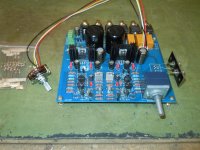 As built.JPG218 KB · Views: 132
As built.JPG218 KB · Views: 132 -
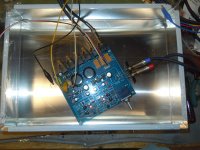 Aluminium box.JPG215.6 KB · Views: 132
Aluminium box.JPG215.6 KB · Views: 132 -
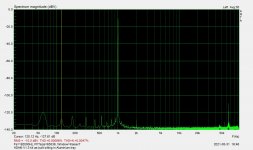 L THD 1V as built sitting in Aluminium tray.jpg166.1 KB · Views: 132
L THD 1V as built sitting in Aluminium tray.jpg166.1 KB · Views: 132 -
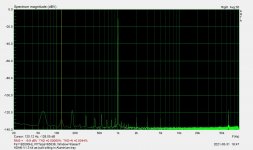 R THD 1V as built sitting in Aluminium tray.jpg166.8 KB · Views: 128
R THD 1V as built sitting in Aluminium tray.jpg166.8 KB · Views: 128 -
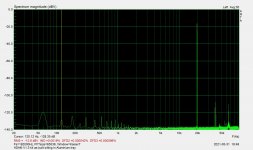 L IMD 1V as built sitting in Aluminium tray.jpg169.1 KB · Views: 129
L IMD 1V as built sitting in Aluminium tray.jpg169.1 KB · Views: 129 -
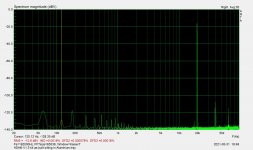 R IMD 1V as built sitting in Aluminium tray.jpg169.7 KB · Views: 74
R IMD 1V as built sitting in Aluminium tray.jpg169.7 KB · Views: 74
Quoted for future reference.Isn't that largely because they don't have the same listening experiences?
Realistic to which real thing, the recording session of a particular album used for demo?If anyone listened to my friend's system, they would be impressed with how realistic a system can be.
Which doesn't mean anything to those without the "same listening experiences" you mentioned.One visiting Japanese audio consultant and reviewer said it was one of the best few systems in the world that he had ever listened to.
Right, such as spending more money on DAC.or else to wasted money.
Hi Demian,
Hmm, it was there this afternoon. I'll attach it.
Many Chinese vendors refer to transistors as tubes. No, they are just moving boxes, they don't have a clue what they are selling.
I'm sorry about the quality of the schematic, but this is what was up there.
This preamp sounds silly good Demian. The kit was $40 Canadian, plus RCA connectors and volume control. I was running about 316 mV in using the volume control. It might measure better if I shorted the volume control out, but this is how it is used so ...
-Chris
Hmm, it was there this afternoon. I'll attach it.
Many Chinese vendors refer to transistors as tubes. No, they are just moving boxes, they don't have a clue what they are selling.
I'm sorry about the quality of the schematic, but this is what was up there.
This preamp sounds silly good Demian. The kit was $40 Canadian, plus RCA connectors and volume control. I was running about 316 mV in using the volume control. It might measure better if I shorted the volume control out, but this is how it is used so ...
-Chris
Attachments
Yes, the positive feedback loop.
It's a Driscoll oscillator, the CLC tank wich resonates at the overtone crystal frequency and suppress the fundamental and the unwanted B-Mode.
The tank has a relatively high Q so has to be tuned to get the oscillator starting.
So what are you adjusting as a result of this measurement? I thought the Driscoll tuning circuit should be (for the SC crystal) of reactance type, not phase shift, and varactor diodes (back to back, to avoid as much as possible their additive noise contribution) is the method of choice for tuning. Why is a VNA required for this adjustment?
Last edited:
No, why would you ask that? It is a common characteristic of all amplifiers.
I found it specifically true with that topology (which uses class-B current buffer). They are usually "designed" to have high current capability.
Increase the SPL and the sound usually becomes subjectively messy.
The zero-feedback topology requires "perfect" amplification in each stages to get to sufficiently low THD. And this usually relies also on perfect zero volt at crossings along the input to output of the voltage amplifier.
Also, H2 is not always sweet, and can be pretty darned annoying.
Yes. But I'm also curious. May be you have never seriously be exposed to using low quality amplifiers/speakers before? You are using commercial amps and speakers.
I build my own amplifiers and speakers, which mean there is a stage where my designs were so very very poor. In this case I learned a lot about bad designs. I understand when I do need "patches" (there are many kinds) and when I don't need them.
In my current amps I don't need H2, even though "sweet" they are annoying I agree, but I don't think this is applicable to less good systems. Few posts back I read someone mentioned that accurate amps sound "flat" and not interesting. I think something is wrong with that amp. Or the speakers.
Hi johnego,
In my experience, good equipment that has very low distortion sounds very involving and do tend to have a flat response.
I have designed a lot of equipment, and my early stuff was so-so. They worked at least. I started out working on 8-tracks, and all-in-one stereo systems with the turntable on top. Believe me, they were less than bad, they were terrible! I worked on early solid state record consoles and also tube units. We are talking a watt or two output power. They didn't have enough power to hurt themselves.
Once I began working on good equipment (was trained at Superscope/Marantz), I began to improve equipment performance. I went to Ryerson here in Toronto before beginning my serious service career. I have always strived to learn more and be the best technician I could be. It's a long road, not easy. Lots of sacrifice as my kids and wife would attest to. Very rewarding now.
So, always try to do better and improve. Buy better equipment as you can, it matters.
-Chris
In my experience, good equipment that has very low distortion sounds very involving and do tend to have a flat response.
I have designed a lot of equipment, and my early stuff was so-so. They worked at least. I started out working on 8-tracks, and all-in-one stereo systems with the turntable on top. Believe me, they were less than bad, they were terrible! I worked on early solid state record consoles and also tube units. We are talking a watt or two output power. They didn't have enough power to hurt themselves.
Once I began working on good equipment (was trained at Superscope/Marantz), I began to improve equipment performance. I went to Ryerson here in Toronto before beginning my serious service career. I have always strived to learn more and be the best technician I could be. It's a long road, not easy. Lots of sacrifice as my kids and wife would attest to. Very rewarding now.
So, always try to do better and improve. Buy better equipment as you can, it matters.
-Chris
In my experience, good equipment that has very low distortion sounds very involving and do tend to have a flat response.
I agree. But I was exposed to this experience only within the last 5 years even though I have chased for holly grail amplifier for more than 20 years. So in my view it is a rare experience and not everyone can understand this.
Exactly.... H2 is not always sweet, and can be pretty darned annoying.
Back in 2018 Nelson Pass published an article about 2nd harmonic distortion art_h2.pdf.
Acoustically, what Nelson Pass called positive phase H2 shows stronger compression peaks of the fundamental compared to rarefaction peaks, which is exactly the type of H2 induced by common dynamic drivers. Which makes it rather cumbersome for us to evaluate characteristics of driver generated negative phase H2 since it requires physical orientation of the driver facing away from the listener.Nelson Pass said:So why is the phase important? Well, it's a subtle thing. I don't suppose everyone can hear it, and fewer particularly care, but from listening tests we learn that there is a tendency to interpret negative phase 2nd as giving a deeper soundstage and improved localization than otherwise. Positive phase seems to put the instruments and vocals closer and a little more in-your-face with enhanced detail.
As I trust him, I do not expect everyone can hear it either, and fewer particularly care. However when one is annoyed by existing H2 then one either find a way to fix it, learn to love the annoyance or stay being annoyed.
And please, I merely quoted published article by Nelson Pass. Anyone who feels the need of any form proof or argue about illusion and delusional quality of sound localization should take it up with him.
So what are you adjusting as a result of this measurement? I thought the Driscoll tuning circuit should be (for the SC crystal) of reactance type, not phase shift, and varactor diodes (back to back, to avoid as much as possible their additive noise contribution) is the method of choice for tuning. Why is a VNA required for this adjustment?
The oscillation frequency is where the phase goes through 0° at exactly one
frequency where the loop gain is slightly > 1.0 . The amplitude of the loop gain
must be < 1.0 at all other frequencies where the phase crosses 0° (i.e. unwanted
overtones, or SC cut B-frequency) or the oscillator may jump from one to
another.
At the same time you must make sure that the steepest dphase vs df happens where
the phase goes through 0°. dphase/df is group delay numerically or effective Q.
When the tank circuit is a minimum phase network, it can be used to shift the
phase +-45° between its -3dB points. The tank circuit is usually the only place
in the oscillator where you can set a phase offset at will.
The -3dB points of the tank are just a landmark. If you need to tune it that
far you will loose some control over the loop gain that needs to be > 1.0,
but just barely.
An excellent crystal buys you nothing if the 0° phase shift happens at a
point of the loop gain curve where it is flat. It will oscillate there, but the
effective Q is best somewhere else, a KHz or more off where it does
no good.
In a Butler osc, the best point to cut the loop open is at the emitters of
the two transistors because there is a nice low impedance level.
In a Driscoll, a good point would be at the base of the transistor that
has the crystal at its emitter.
Rhea writes that with the Randall-Hock formula you can even cut in
the resonator of an LC colpits. Rhea is the main author of
Keysight's Genesys product.
In a VCXO, the varactors set the exact frequency at a 100Hz level
by changing the crystal resonance and ITS 180° phase shift, but
the tank selects the harmonic and sets the delay niveau so that
the crystal has the right environment.
Last edited:
Imo, it is not the H2 that is important (but true that some people like it because it's sweet, in the absence of a better accurate sound) but how the H2 will mask other higher order distortions.
In class-B where there are lots of high-order distortion, reducing H2 doesn't make sense. But in class-A where low order and H2 usually dominates it does make sense. And H2 has a more consistent phase behaviour (than higher order ones) that intuitively I don't see why "pre-distortion" (I don't like the term either) not feasible.
Pre-distorsion is a technical concept and not just any "term" to like or not. It's not used in any hifi equipment so forget about it.
Are you sure H2 masks higher order? Do you have a source on that?
//
It's not used in any hifi equipment so forget about it.
It might be being used by ESS inside some of their latest DAC chips. There they have means to correct for very low-level DAC distortion by tweaking some digital registers. But others with first-hand experience would be better placed to talk about this - for example @Markw4.
Hi Demian,
Hmm, it was there this afternoon. I'll attach it.
Many Chinese vendors refer to transistors as tubes. No, they are just moving boxes, they don't have a clue what they are selling.
I'm sorry about the quality of the schematic, but this is what was up there.
This preamp sounds silly good Demian. The kit was $40 Canadian, plus RCA connectors and volume control. I was running about 316 mV in using the volume control. It might measure better if I shorted the volume control out, but this is how it is used so ...
-Chris
Its a good circuit. Been around in variations for a long time. Below is the LH0032 which I used the Spectral CPU100 at the dawn of audio it seems (1975?). The Marantz is a variation on the same. So was Curl's first preamp for Levinson (phono section). I have worked on variations of this with great success. The Hybrids are history but SMT works almost as well. There are some enhancements to be made but the general form has worked for many.
Attachments
So what are you adjusting as a result of this measurement? I thought the Driscoll tuning circuit should be (for the SC crystal) of reactance type, not phase shift, and varactor diodes (back to back, to avoid as much as possible their additive noise contribution) is the method of choice for tuning. Why is a VNA required for this adjustment?
There are no varactors in our Driscoll oscillator, they add noise.
So the phase shift of the tank is crucial to get the oscillator starting.
(Simulated gain and phase of the CLC tank)
Attachments
- Status
- Not open for further replies.
- Home
- Member Areas
- The Lounge
- Sound Quality Vs. Measurements
